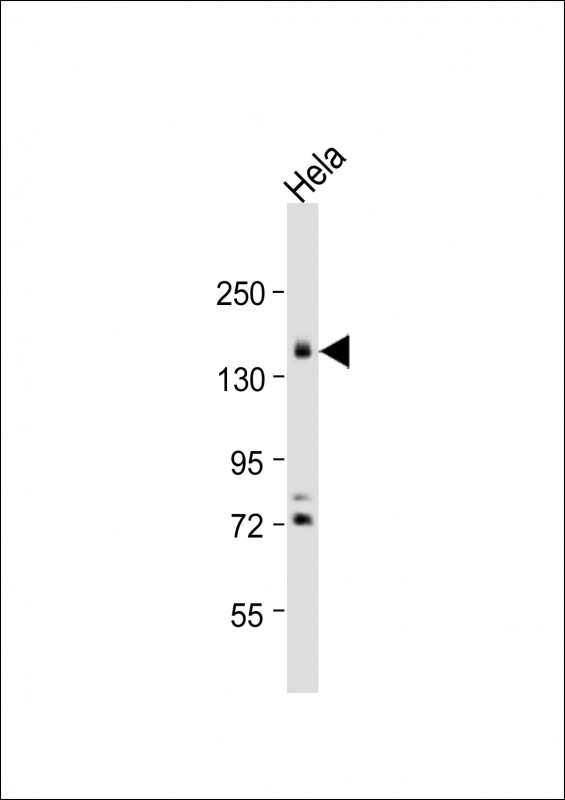
| WB | 1/1000 | Human,Mouse,Rat |
| IF | 咨询技术 | Human,Mouse,Rat |
| IHC | 咨询技术 | Human,Mouse,Rat |
| ICC | 技术咨询 | Human,Mouse,Rat |
| FCM | 咨询技术 | Human,Mouse,Rat |
| Elisa | 咨询技术 | Human,Mouse,Rat |
| Aliases | Podocalyxin, GCTM-2 antigen, Gp200, Podocalyxin-like protein 1, PC, PCLP-1, PODXL, PCLP, PCLP1 |
| Entrez GeneID | 5420 |
| WB Predicted band size | 58.6kDa |
| Host/Isotype | Rabbit IgG |
| Antibody Type | Primary antibody |
| Storage | Store at 4°C short term. Aliquot and store at -20°C long term. Avoid freeze/thaw cycles. |
| Species Reactivity | Human |
| Immunogen | This PODXL antibody is generated from rabbits immunized with a KLH conjugated synthetic peptide between 410-439 amino acids from the C-terminal region of human PODXL. |
| Formulation | Purified antibody in PBS with 0.05% sodium azide. |
+ +
以下是3篇关于PODXL抗体的研究文献(内容基于公开研究整理,部分信息可能需进一步核实):
1. **文献名称**:*"Podocalyxin as a prognostic marker in colorectal cancer"*
**作者**:Somasiri A. et al.
**摘要**:研究通过免疫组化分析结直肠癌组织中PODXL的表达,发现其高表达与患者总生存期缩短相关,提示其可作为潜在的预后生物标志物。
2. **文献名称**:*"Podocalyxin promotes invasion and metastasis in breast cancer through EMT activation"*
**作者**:Cheng J. et al.
**摘要**:利用PODXL抗体检测乳腺癌细胞系及组织样本,发现PODXL通过激活上皮间质转化(EMT)增强癌细胞侵袭和转移能力。
3. **文献名称**:*"Targeting Podocalyxin in aggressive renal cell carcinoma"*
**作者**:Sizemore S. et al.
**摘要**:研究使用抗PODXL抗体阻断其功能,发现可抑制肾癌细胞迁移和肿瘤生长,为靶向治疗提供实验依据。
如需具体文献来源,建议通过PubMed或Google Scholar检索标题及作者获取全文。
PODXL (Podocalyxin) is a transmembrane sialomucin glycoprotein belonging to the CD34 family of cell surface receptors. Initially identified in kidney podocytes, it plays a critical role in maintaining the structure and function of the glomerular filtration barrier by regulating foot process architecture and cell adhesion. Structurally, PODXL features a heavily glycosylated extracellular domain, a single transmembrane region, and a cytoplasmic tail that interacts with cytoskeletal linkers like ezrin and NHERF2. facilitating connections to the actin cytoskeleton. Its extracellular domain carries strong negative charges due to sialic acid residues, contributing to anti-adhesive properties and cellular repulsion.
Beyond renal physiology, PODXL is expressed in vascular endothelia, hematopoietic progenitors, and certain epithelial tissues, where it influences cell polarity, migration, and differentiation. Notably, it has gained attention in oncology due to its overexpression in multiple cancers, including colorectal, breast, and pancreatic carcinomas. Elevated PODXL correlates with aggressive tumor behavior, metastasis, and poor prognosis, likely through promoting epithelial-mesenchymal transition (EMT) and immune evasion.
PODXL antibodies are widely used in research and diagnostics to detect expression patterns in tissues or cell lines via techniques like immunohistochemistry, flow cytometry, or Western blot. They serve as tools to investigate PODXL's biological roles and its potential as a therapeutic target or biomarker in renal diseases and cancer. Isoform-specific antibodies further help distinguish between different splicing variants with distinct functional implications.
×